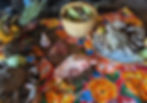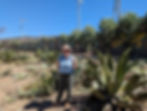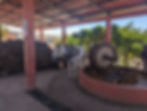Pechuga Mezcal and How Mezcal is Made
- Maria DiCicco
- Apr 9, 2024
- 5 min read
Updated: Jan 31
Recently I had the honor of being present at Gracias a Dios distillery in Oaxaca when they were harvesting agave for the next batch of mezcal, something that happens only once or twice a year.
Even better, I was there just in time to bear witness to a special process of making mezcal called "pechuga mezcal". This special liquor was being created especially for infamous Chef Javier Plascencia from Baja.
This unique experience brought me up close and personal not only with his family, but also with the celebratory process of making Pechuga Mezcal. Below I'll detail a bit about the steps in its most basic form, and share with you a link to purchase this year's coveted batch of Pechuga from the collaboration between Gracias a Dios and Javier Plascencia.
Note: Always Pack Tissues represents many tried and tested travel sites as what is called an 'affiliate' partner. That means if you click on my ads I may get a commission from a resulting sale.

What is Mezcal?
In it's simplest explanation, mezcal is a liquor made from agave, most notably in the state of Oaxaca, Mexico.
Typically clear or golden in color, mezcal's most distinctive characteristic is the smokiness that comes in as part of the cooking process.

What is Pechuga Mezcal?
Pechuga means "breast" in Spanish, most commonly used in relevance to chicken or turkey breast.
When making pechuga mezcal, the raw turkey breast is an essential part of the cooking process, bringing in flavorful nuances from a more basic batch, along with botanicals, herbs and vegetables. We'll learn more about this in this article.

What's The Process For Making Mezcal?
As we gathered around our tour guide for the morning tour, we noticed immediately that the majority of their agave field had been harvested the day before.
Step 1
Grow the agave, which takes 6 years and up!
Depending on the variety of agave, it may take longer. There are something like 42 types of agave!
Tobala, cuishe and arroqueno are some of the longer to grow types (sometimes 8-12 years), and espadin is the most common and fastest to mature.
Some of the characteristics and tasting notes I took when we were sampling:
Espadin: smoky
Tobala: mineral profile
Cuishe: earthy
Tepeztate: 25 yrs to mature!!
It's definitely worth scheduling a tasting tour to learn more about mezcal versus winging it. Without a tour I wouldn't have been able to visualize the types of plants, and understand how each one got its flavor profile.
Understanding the maturation process of each plant variety is key to harvesting on time. Sometimes it is evident with the visibility of a flower or yellowing of the leaves, among other signs.
Step 2
Harvest time!
When the heart of the agave is mature, they get to whackin'!

The agave is trimmed down to the piña, which frankly looks a lot like the body of a pineapple, so the name makes sense.
Step 3
Fire it Up!
Hot lava stones burn in a big pile like charcoal for 8-9 hours until rocking hot.

Once hot enough, the piña (agave heart) is tossed on top with layers of agave fibers (maguey), pulp dirt and for cooking.
Step 4
Wait A Few Days
Maybe make some grilled oysters over the burning agave while you wait...Javier Placencia did!
Step 5
Grind the Agave
A one-horse spindle grinds the agave to a pulp (literally), and the horse powers the wheel.

At this point you can taste the fibers, which are like a vanilla sugarcane. It tastes incredible!
Step 6
Rest and Ferment
Take the ground agave and put in a pine vat for natural fermentation. It develops a crust.
The maestro mezcalero will sample it until it is ready to go into the distillation tanks (in about 2 weeks time).
Step 7
Distill, Baby, Distill
Combined with boiling water, the copper vats burn off the alcohol, which drips into jugs for bottling and consumption. This takes only a few hours!

How Is Making Pechuga Mezcal Different?
For pechuga, an additional step is needed. Add vegetables, raw turkey breast, etc, into a net and drop them into the copper pot phase like you were infusing a stew.
Last year's batch of Pechuga from Javier Plascencia was a lobster infused Pechuga, and in case you didn't think that could be topped - this year he used crab and oysters.

The spread of things that went into the distillation vat was truly eye-popping. Some of the things included were:
sea bean, an incredibly delicious salty sea weed
oysters
onions
giant crab
turkey breast
apples
corn
squash and squash blossoms
bananas
The Result
This time honored process has been passed from generation to generation in the "Gracias a Dios" family, making top of the line mezcals infused with heart, soul, and I guess in this case, crab meat.
Made with care and love, the Gracias a Dios team and the Plascencia family raised a glass to thank everyone for their participation, rubbed a bit on their newest child's forehead as a "Oaxacan Baptism", and poured a little to "La Tierra", all in thanks for the bounty.

Gracias a Dios in particular has my heart and likely many more visits from me in the future, although many other distilleries in Oaxaca deserve equal praise, so be sure to visit others while you are in range of the Camino de Mezcal in Oaxaca.
Taking Mezcal Home
Taking Mezcal home from Mexico to the US is as easy as taking home wine. You can consult what I know about liquid limits for alcohol here, but before you do, consider how you will bring it home.
I highly recommend purchasing a wine suitcase from VinGardeValise. These guys know what they are doing when it comes to securely packaging alcohol. I've had my suitcase for years, and on my last trip to Oaxaca, check how loaded up it was!

Browse out to that link above for a special discount, or use ALWAYS20 at checkout for 20% off.
Learn more about these cool bags at my wine suitcase review here.
Where Can I Buy Pechuga Mezcal?
Lucky me, I bought some of last year's pechuga de langosta while I was there, but you will have to go to Oaxaca and visit Gracias a Dios for a special bottle of the newest batch of Pechuga!

Or, contact Gracias a Dios and see where they may have it on shelves or if shipping is a possibility.
Check out their website here, and then head on over to my round up of distilleries and tours of the Palenques in Oaxaca where you can sample mezcal for yourself.
Salud!






























